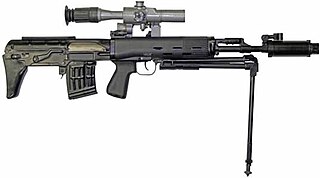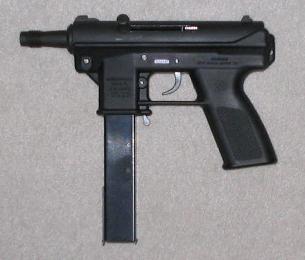
A revolver is a repeating handgun that has at least one barrel and uses a revolving cylinder containing multiple chambers for firing. Because most revolver models hold up to six cartridges, before needing to be reloaded, revolvers are commonly called six shooters or sixguns. Due to their rotating cylinder mechanism, they may also be called wheel guns.

A bullpup firearm is one with its firing grip located in front of the breech of the weapon, instead of behind it. This creates a weapon with a shorter overall length for a given barrel length, and one that is often lighter, more compact, concealable and more maneuverable than a conventionally configured firearm. Where it is desirable for troops to be issued a more compact weapon, the use of a bullpup configuration allows for barrel length to be retained, thus preserving muzzle velocity, range and ballistic effectiveness.

The National Firearms Act (NFA), 73rd Congress, Sess. 2, ch. 757, 48 Stat. 1236 was enacted on June 26, 1934, and currently codified and amended as I.R.C. ch. 53. The law is an Act of Congress in the United States that, in general, imposes an excise tax on the manufacture and transfer of certain firearms and mandates the registration of those firearms. The NFA is also referred to as Title II of the federal firearms laws, with the Gun Control Act of 1968 ("GCA") as Title I.

The Military Armament Corporation Model 10, officially abbreviated as "M10" or "M-10", and more commonly known as the MAC-10, is a compact, blowback operated machine pistol/submachine gun that was developed by Gordon Ingram in 1964. It is chambered in either .45 ACP or 9mm. A two-stage suppressor by Sionics was designed for the MAC-10, which not only abates the noise created but makes it easier to control on full automatic.

An automatic firearm or fully automatic firearm is a self-loading firearm that continuously chambers and fires rounds when the trigger mechanism is actuated. The action of an automatic firearm is capable of harvesting the excess energy released from a previous discharge to feed a new ammunition round into the chamber, and then igniting the propellant and discharging the projectile by delivering a hammer or striker impact on the primer.

The Intratec TEC-9, TEC-DC9, KG-99, and AB-10 are a line of blowback-operated semi-automatic pistols. They were developed by Intratec, an American subsidiary of the Swedish firearms manufacturer Interdynamic AB. Introduced in 1984, the TEC-9 was made of inexpensive molded polymers and a mixture of stamped and milled steel parts. The simple design of the gun made it easy to repair and modify. It was a commercial success, with over 250,000 being sold.
The Remington Model 870 is a pump-action shotgun manufactured by Remington Arms Company, LLC. It is widely used by the public for shooting sports, hunting and self-defense, as well as by law enforcement and military organizations worldwide.

The .32 S&W Long, also known as 7.65x23mm, is a straight-walled, centerfire, rimmed handgun cartridge, based on the earlier .32 S&W cartridge. It was introduced in 1896 for Smith & Wesson's first-model Hand Ejector revolver. Colt called it the .32 Colt New Police in revolvers it made chambered for the cartridge.

The Cobray Company was an American developer and manufacturer of submachine guns, automatic carbines, handguns, shotguns, and non-lethal 37 mm launchers. These were manufactured by SWD. In the 1970s and 1980s, Cobray was a counter terrorist training center in addition to being an arms maker under the leadership of Mitch WerBell.

The LeMat revolver was a .42 or .36 caliber cap & ball black powder revolver invented by Jean Alexandre LeMat of France, which featured an unusual secondary 16 to 20 gauge smooth-bore barrel capable of firing buckshot. It saw service with the armed forces of the Confederate States of America during the American Civil War of 1861–1865 and the Army of the Government of National Defense during the Franco-Prussian War.

Rotating bolt is a method of locking the breech of a firearm closed for firing. Johann Nicolaus von Dreyse developed the first rotating bolt firearm, the "Dreyse needle gun", in 1836. The Dreyse locked using the bolt handle rather than lugs on the bolt head like the Mauser M 98 or M16. The first rotating bolt rifle with two lugs on the bolt head was the Lebel Model 1886 rifle. The concept has been implemented on most firearms chambered for high-powered cartridges since the 20th century.
A rim is an external flange that is machined, cast, molded, stamped, or pressed around the bottom of a firearms cartridge. Thus, rimmed cartridges are sometimes called "flanged" cartridges. Almost all cartridges feature an extractor or headspacing rim, in spite of the fact that some cartridges are known as "rimless cartridges". The rim may serve a number of purposes, including providing a lip for the extractor to engage, and sometimes serving to headspace the cartridge.

Harrington & Richardson Arms Company is an American brand of firearms and a subsidiary of JJE Capital Holdings. H&R ceased independent production February 27, 2015.

Arcadia Machine & Tool, commonly abbreviated to AMT, was a firearms manufacturer from Irwindale, California. The company produced several weapons, primarily clones of existing firearms, but made from stainless steel rather than the standard steel used for most firearms of the time.

Short-barreled rifle broadly refers to any rifle with an unusually short barrel. The term carbine describes a production rifle with a reduced barrel length for easier handling in confined spaces. Concern about concealment for illegal purposes has encouraged regulations specifying minimum barrel lengths and overall lengths.

A vertical forward grip or foregrip is a vertical pistol grip mounted on the fore-end of a long-barrel firearm, designed for grasping by the frontal support hand.

A handgun is a firearm designed to be usable with only one hand. It is distinguished from a long gun which needs to be held by both hands and braced against the shoulder. Handguns have shorter effective ranges compared to long guns, and are much harder to shoot accurately. While most early handguns are single-shot pistols, the two most common types of handguns used in modern times are revolvers and semi-automatic pistols, although other handguns such as derringers and machine pistols also see infrequent usage.

The Taurus Judge is a five shot revolver designed and produced by Taurus International, chambered for .410 bore shot shells and the .45 Colt cartridge. Taurus promotes the Judge as a self-defense tool against carjacking and for home protection.

The Smith & Wesson M&P15 is an AR-15 style semi-automatic rifle by Smith & Wesson. Introduced in 2006, the firearm is designed for police use and consumer markets.

The Colt House Revolver was one of the first metallic cartridge rear-loading revolvers to be produced by the Colt's Patent Fire Arms Manufacturing Company, in 1871. The same year, Colt's also patented the Colt Open Top, another metallic cartridge rear-loader, but in fact the Open Top production didn't start until 1872, although a pocket version of the Open Top, a completely different design, went on sales as of 1871, the Colt Open Top Pocket Model Revolver.


















